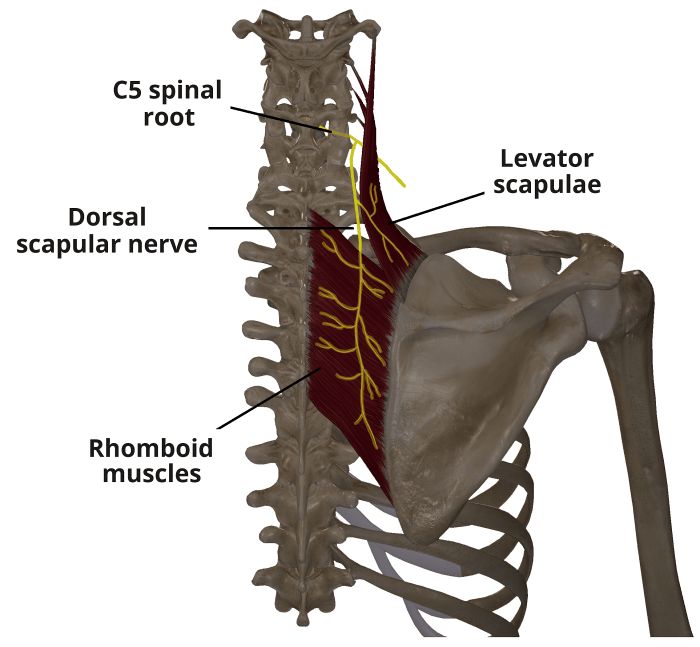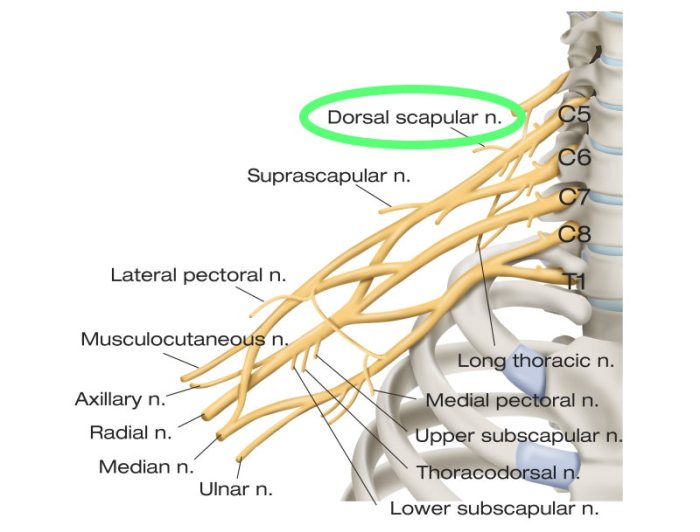The dorsal scapular nerve entrapment test, a valuable diagnostic tool, takes center stage in this comprehensive exploration. Uncover the intricate details and implications of this test, shedding light on its significance in identifying and managing dorsal scapular nerve entrapment.
This meticulously crafted guide delves into the clinical presentation, imaging studies, differential diagnosis, treatment options, and prognosis of dorsal scapular nerve entrapment. Prepare to embark on an enlightening journey, gaining a profound understanding of this condition.
Dorsal Scapular Nerve Entrapment Test: Overview

The dorsal scapular nerve entrapment test is a physical examination maneuver used to assess for compression or irritation of the dorsal scapular nerve. This nerve originates from the brachial plexus and innervates the rhomboid muscles and levator scapulae muscle, which are responsible for shoulder elevation and retraction.
Dorsal scapular nerve entrapment can occur due to various factors, including trauma, repetitive overhead activities, or anatomical variations. It can cause pain, weakness, and sensory changes in the shoulder and scapular region.
Clinical Presentation
The clinical presentation of dorsal scapular nerve entrapment typically includes:
- Shoulder and scapular pain, especially with overhead activities
- Weakness in shoulder elevation and retraction
- Sensory changes, such as numbness or tingling, in the scapular region
- Tenderness to palpation over the dorsal scapular nerve
Physical examination maneuvers used to assess for dorsal scapular nerve entrapment include:
- Adson’s test: Evaluates for compression of the nerve in the thoracic outlet
- Cross-arm test: Assesses for nerve compression in the shoulder
- Scapular compression test: Tests for compression of the nerve at the superior border of the scapula
These tests have varying sensitivity and specificity for diagnosing dorsal scapular nerve entrapment.
Imaging Studies
Imaging studies can be helpful in confirming the diagnosis of dorsal scapular nerve entrapment.
- Magnetic resonance imaging (MRI): Can visualize nerve compression or enlargement
- Ultrasound: Can assess for nerve thickening or fluid collections around the nerve
Typical imaging findings associated with dorsal scapular nerve entrapment include:
- Nerve enlargement or edema
- Compression of the nerve by surrounding structures
- Presence of fluid-filled cysts or masses
Differential Diagnosis, Dorsal scapular nerve entrapment test
Several other conditions can mimic the symptoms of dorsal scapular nerve entrapment, including:
- Cervical radiculopathy: Compression of a nerve root in the neck
- Shoulder impingement: Compression of the rotator cuff tendons in the shoulder
- Thoracic outlet syndrome: Compression of nerves and blood vessels in the thoracic outlet
- Suprascapular nerve entrapment: Compression of the suprascapular nerve, which innervates the supraspinatus and infraspinatus muscles
Differentiating between these conditions is based on the patient’s history, physical examination findings, and imaging studies.
Treatment Options
Treatment for dorsal scapular nerve entrapment depends on the severity of the condition and the underlying cause.
Conservative treatment options include:
- Rest and activity modification
- Physical therapy to improve posture and shoulder mechanics
- Injections of corticosteroids or local anesthetics
Surgical treatment may be necessary in severe cases or if conservative treatment fails. Surgery involves releasing the compressed nerve or removing any structures causing the compression.
Prognosis and Recovery
The prognosis for dorsal scapular nerve entrapment is generally good with early diagnosis and treatment.
Most patients experience significant improvement in symptoms with conservative treatment. However, recovery time can vary depending on the severity of the condition.
Factors that can influence the outcome of treatment include:
- Duration of nerve compression
- Severity of nerve damage
- Patient’s overall health and fitness
Questions and Answers: Dorsal Scapular Nerve Entrapment Test
What are the common symptoms of dorsal scapular nerve entrapment?
Pain, numbness, and weakness in the shoulder and upper back are common symptoms.
How is the dorsal scapular nerve entrapment test performed?
The test involves applying pressure to the nerve in different positions to assess for pain or other symptoms.
What is the significance of imaging studies in diagnosing dorsal scapular nerve entrapment?
Imaging studies, such as MRI and ultrasound, can help visualize the nerve and identify any abnormalities or compression.
What are the treatment options for dorsal scapular nerve entrapment?
Treatment options include conservative measures like physical therapy and injections, as well as surgical intervention in severe cases.

